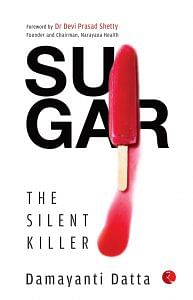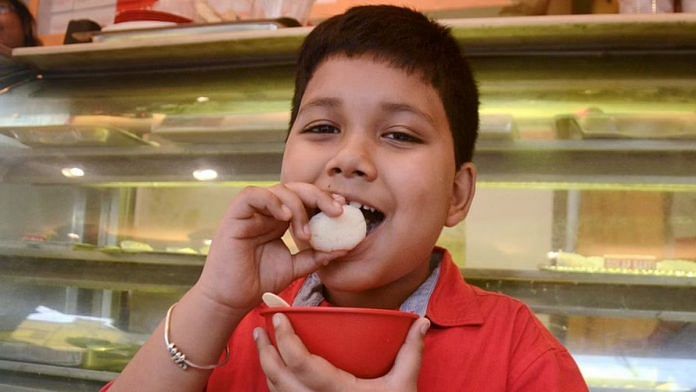Before I was born, an accident of geography and history had created a people with a bad case of sweet tooth. They lived in isolation in a marshy land surrounded by dense forests, disconnected hill systems and a myriad of waterways, including some of the largest rivers in South Asia: the Ganges, the Brahmaputra and the Meghna. An inaccessible eastern frontier to the North Indian plains since time immemorial, it was linked to the rest of the Indian subcontinent with only three hazardous passes— Teliagarhi, Tirhut and Jharkhand—before the advent of the railways in the nineteenth century.
The region was peripheral not just in location, but also as a discursive construct. It was unknown to the composers of the Rig Veda. Later, Vedic texts scorned it as a land of barbarians, where rites and cults of animism, totem and magic were practised. Agni, the God of Fire, refused to cross the frontier.
In Patanjali’s Mahabhashya (second century bce), it was excluded from the land of the Aryans, or what was known as Aryavarta. This exclusion ensured that caste system remained relatively flexible within this territory. Brahmins here ate fish and meat, which was frowned upon elsewhere, and wrote texts justifying their eating habits. The vantage point gave rise to a distinctive regional identity. In the Mahabharata war, the region allied with the anti-heroes, the Kauravas. The Nastika school of philosophy, which like Buddhism, Jainism and Ajivika rejects the authority of the Vedas, flourished.
Also read: Your modern diet is contributing to climate change — but here’s how you can fix it
Tantric mysticism, which spurns caste and patriarchy, exerted a strong hold, democratizing society, and giving right of worship to women and people down the class and caste ladder. Folk pantheons and the tradition of goddess worship found new clout and legitimacy. Challenging the mainstream was so endemic here that under the Mughals, the region even came to be known as the ‘home of revolts’. Identity played out at the intersection of folkways and food ways. Distinctive culinary habits based on the availability of local ingredients as well as new cultural and gastronomic influences, created a cuisine that was pluralistic yet their own. Rice grew abundantly in the fertile floodplains. The medieval text, Shunya Purana, mentions 50 different varieties of rice grown in this region. Rice—boiled, puffed, flattened or parched— was their abiding staple. And they loved fish, a nod to pre-Aryan linkages in a riverine landscape.
The first Bengali text, the Charyapada, composed between tenth and twelfth century ce, described fishing and hunting, apart from a range of food crops, vegetables and fruits. Matsya (fish), mamsa (meat) and mudra (parched grains) were also among the five Ms enjoined by Tantra.
People spent an enormous amount of time, energy— and, yes, emotion—on food and cooking: from procuring, selecting, preparing, serving and eating, to thinking and talking about it. There was much play between distinctive flavours, mouthfeel and a procession of tastes in a total meal, from bitter to sweet. Text after text depicted the eating culture of the region. A verse from Prakrita Paingala, a thirteenth-century text from Bengal, mentioned the idea of a fulfilled man: ‘Fortunate is the man whose wife serves him on a banana leaf hot rice with ghee, mourala fish, fried leaf of jute plant, and hot milk. This culinary imagination was not just a matter of preference. It was resistance to the colonization of taste, too. It allowed the region to break taboos and set new styles in motion with every new influence: political, religious or entrepreneurial. For instance, the injunctions of the Smriti writers on cooked fish and meat were recommended by the eleventh-century physician and commentator of Ayurveda, Chakrapanidatta.
The most visible example of their cosmopolitan culinary identity was, perhaps, of using chhana (or unripened cheese) as a medium for sweets after the arrival of the Portuguese in the sixteenth century. The Vedic taboo on the deliberate curdling of milk was broken only here. Chhana became the defining element of Bengali dessert ever since. Chhana was the last ingredient to be added to the perfect storm of sweet tastes and flavours that marked the region since ancient times. It was the original seat of the high-quality sugar cane Paundra or Paundraka mentioned in the second century bce medical text Charaka Samhita.
Also read: From vegicken curry to vegan mutton tikkas, mock meat players race to win Indian tastebuds
From sugar cane came the name Paundra Vardhana, the ancient kingdom of northern Bengal, with poets singing paeans to the beauty of sugar cane fields. The art of making sugar cane juice and sugar was applied to the madhuka flower (mahua) and date palm (khejur) as well. It was in the fitness of things that a land famous for the cultivation of sugar cane had its ancient name, Gauda, after a key sugar cane product: gur or molasses. The seventh-century Tang emperor of China, Tai-Hung, sent emissaries to learn the art and craft of sugar making from India (Lyu) and especially Bengal (Mo-Ki-To).
Medieval literature testified to the region’s long-standing fascination for all things sweet. One felt like a king, went a verse in Prakrita Paingala, with enough clarified butter (ghitta) to prepare 20 cakes of fried sweets (pistaka).
Up to the eighteenth century, sugar was a key item of flourishing trade in Bengal with coastal Africa, the Persian Gulf, Southeast Asia, Tibet and China. It was, however, an aromatic variety of molasses from the sap of silver date palm (Phoenix sylvestris) that made their sweets truly different. Sourcing palm sap for making wine or toddy was widely practised across the world since ancient times, but it harmed the trees. What developed in this region was an unusual skill: tapping the tree, without harming it, for jaggery—variously called, khejur gur, nolen gur, jhola gur or patali gur. Perfected over centuries, a specialized profession of tree tappers emerged, who knew when to climb the trees in winter, how to make the right incisions and where to tie clay pots to collect the sap overnight.
 This excerpt from Damayanti Datta’s ‘Sugar: The Silent Killer’ has been published with permission from Rupa Publications.
This excerpt from Damayanti Datta’s ‘Sugar: The Silent Killer’ has been published with permission from Rupa Publications.



